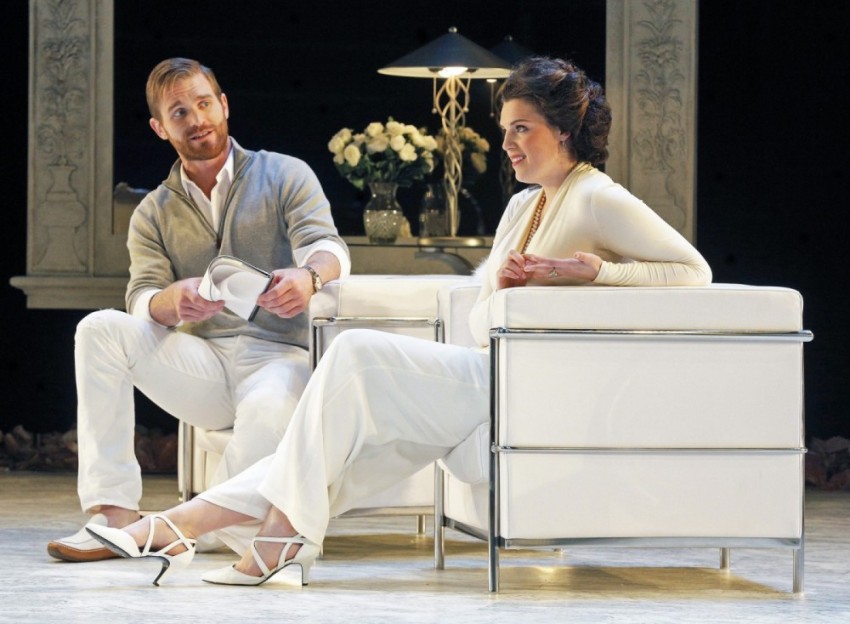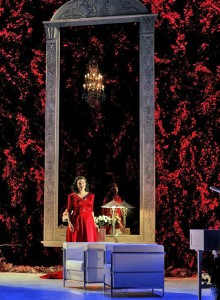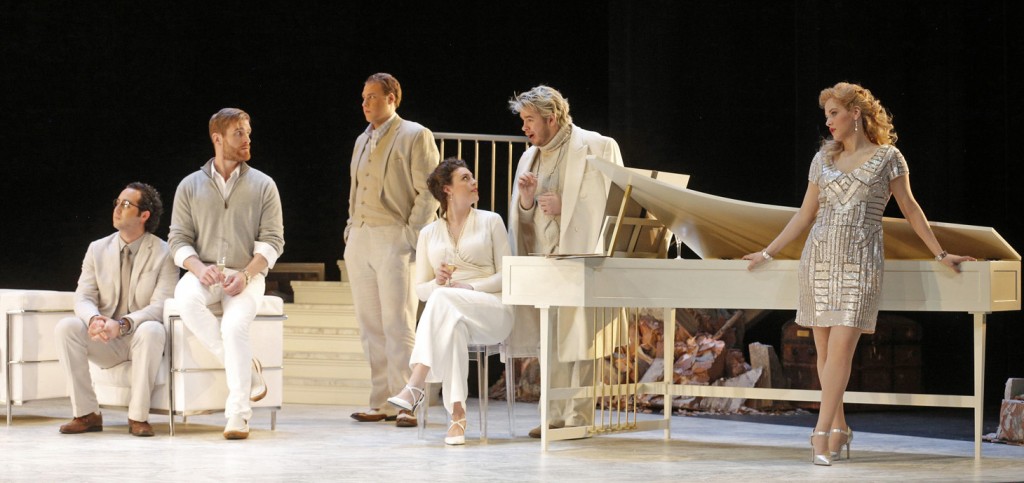
Capriccio, by Richard Strauss. Opera Philadelphia/Curtis Institute of Music, 2016
Which is more important, words or music? That’s the question debated by Richard Strauss in the final opera of his long life. It’s a question that this critic faces continually.
At age 78, in the midst of World War II, Richard Strauss created Capriccio, a story about a woman, the Countess Madeleine, who is pursued by two men. One is a poet, the other a composer. During two hours of musical conversation in her château, the men debate whose work is more important and, simultaneously, romance the woman.
Strauss co-wrote the libretto (with his friend, the conductor Clemens Krauss) and wrote the music too. No one was more qualified to weigh the merits of melody as compared to verse; this was, after all, his 15th opera. The subject makes a fascinating argument.
In the Countess’s salon the poet Olivier and the composer Flamand argue back and forth. “First the words, then the music,” “First the music, then the words,” “Music wakes feelings which need words,” “Music lifts you to spheres where thought cannot penetrate,” “Let her decide.”
While the two men tout their creative importance, they simultaneously try to impress Madeleine in a romantic way.
The theater director La Roche chimes in and says that both words and music are subservient to what he provides. He’s the guy who has to put the show on stage and entertain the public. His comments are sarcastically funny: “The malady of opera is the deafening din of the orchestra. The singers are driven to screaming, so no one can hear the text, good or bad, anyway.”
Strauss wrote this piece for a large orchestra but it’s kept soft and transparent through every part of this opera except La Roche’s narrative. The 59 Curtis Institute musicians played Strauss’s subtle score with delicacy and color, led by Timothy Myers.
As her guests disperse, Countess commissions Olivier and Flamand to collaborate and write something based on the discussions of that afternoon. She is in love with two men but doesn’t know which is her preference. To figure it out she has them write an opera, even though some of her guests have been making fun of that art form.
This is reminiscent of Strauss’s Ariadne auf Naxos, where a rich party-giver intends to present for his guests a serious drama and a comedy performed by a commedia dell’arte group. There isn’t enough time, so he orders his entertainers to perform both simultaneously. Capriccio is full of other allusions to previous Strauss operas (for instance, the leading lady contemplating her reflection in a mirror, as in Rosenkavalier). 
In the final scene, the Countess is alone in the evening. Still undecided about her affections, she sings of the inseparability of words and music as she gazes into the mirror. A major-domo announces “Dinner is served” and the opera ends, with no decision made.
It’s heartening to witness how the old man could still be aware of, and write about, sexual desire. Strauss also was a sentimentalist. He closed the score of Capriccio with a few phrases for the solo French horn player of the Munich Opera, which was the position once held by Strauss’s father.
Countess Madeleine normally is played by a mature woman, and the conversation takes place on a lofty, philosophical level. I saw Kiri Te Kanawa perform the role in 1998 at age 53, and Renée Fleming in 2011 at 52. That need not be the case; Strauss did not specify the character’s age.
Everyone in this production was in their twenties, and the countess was played by the 25-year-old Kirsten MacKinnon. This was a sexually-charged interpretation, and the grabbing and kissing worked wonderfully. Previous productions always seemed like intellectual discourses but this was an exciting drama played on two levels. Of all the performances I’ve seen of Capriccio, this was the most compelling.
Those of us who love music and theater perpetually face such a choice. Words appeal to my mind, music to my soul. Sometimes I have to make a selection on a given day whether to attend a play or a concert. When I’m in the mood for stimulation I turn to theater, when I’m in need of comfort I tend towards music. The best amalgam, to me, is opera, which has moments of solace and others of excitement. And it adds, as La Roche said, fireworks.
The superb performers of this production, in the orchestra pit and on the stage, delivered this mixture with skill, wit and enthusiasm. Chas Rader-Shieber directed so that every gesture and expression seemed natural. Tenor Evan LeRoy Johnson was Flamand, baritone Dogukan Kuran was Olivier, bass-baritone Tyler Zimmerman was La Roche, baritone Jarrett Ott was the Countess’s brother who was pursuing the actress Clairon, played by mezzo Lauren Eberwein.
Ballerina Emily Davis was a party guest as were Roy Hage and Ashley Milanese as caricatures of Italian singers. Robert Perdziola’s set placed a stylish Art Deco château amidst the rubble of wartime bombing raids, and his costumes were in shades of beige and white. La Roche looked delicious with his streaked hair colors, turtle neck shirt and a topcoat draped from his shoulders.
Capriccio was not well-received by the world in 1942. Critics of that time concluded that the quality of Strauss’s work nose-dived after Rosenkavalier (1911) and everything he wrote in his later years was retrograde rehash. Composer Hans Werner Henze wrote that Strauss “lacks all moral force…He was a fraud as a genius.”
It’s true that he seemed to retreat from the world when he turned away from a World War to compose this treatise (while he tried to get Nazi leaders to release his Jewish daughter-in-law, who had been arrested).
Strauss apparently was a self-centered man, and he avoided confrontation with Naziism to concentrate on his own craft. Nevertheless, this is a fascinating summing up of his real concerns in life, music and theater.

An earlier version of this article appeared in Broad Street Review
Please share your thoughts and your opinions with us. Address to editor@theculturalcritic.com
Read other reviews on The Cultural Critic